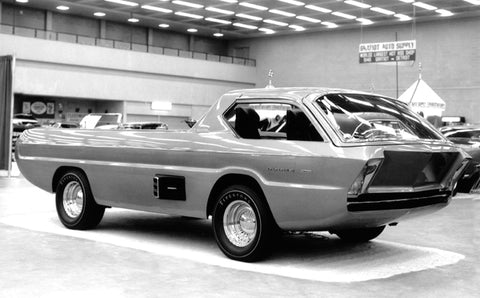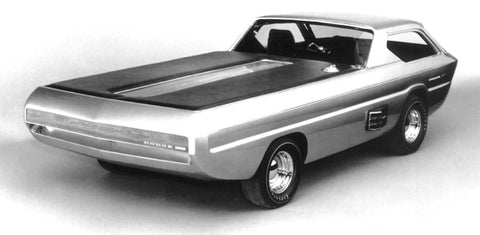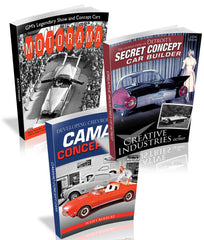1967 Dodge Deora
With a wheelbase of 90 inches, Deora measured 189 inches overall. It was 79 inches wide and stood 57 inches tall. It rode on custom-built deep-dish reversed chrome wheels fitted with 10.50x13 Firestone “Little Indy” racing tires.
The trend towards personal-use pickups was barely in the public’s consciousness when renowned Detroit customizers Larry and Mike Alexander were commissioned to build the Dodge Deora.
At the time, Chrysler engineers, designers, and product planners felt that there would be a tremendous upsurge in the sale of vehicles based on a pickup format. They anticipated these vehicles of the not-too-distant future would combine the creature comforts of a luxurious town sedan with the sporty individuality of a European GT car packaged in the amazing utility of a pickup truck. With tonneau cover in place, Deora would serve as a personal car everywhere. With tonneau cover removed, there would be ample room for a matching “slide on” type camper unit for family recreational travel. Without the camper unit in place, Deora would be equally practical as a cargo carrier for the businessman, the homeowner, and the sportsman. History has proven them right, and at the time the company said, “Deora—far more than a stylist’s dream—is the first bold step into the virtually unexplored field of the true sports-pickup.”
Designed by Harry Bentley Bradley, who was at the time employed by GM but was moonlighting for the Alexanders, Deora was based on a Dodge A-100 pickup. It was chopped and sectioned from the stock height of 78 to just 57 inches tall and featured a unique split front door, the top half of which had actually seen service as the tailgate of a ’60 Ford wagon.
Because of Deora’s unique front-entry, the manifold vacuum, fuel, alternator, water temperature, and oil pressure gauges were mounted in a wood-grained panel located to the driver’s left, just above the built-in armrest. All were fully functioning Stewart Warner custom instruments, as were the tachometer and speedometer housed in individual, self-illuminated nacelles mounted on Deora’s custom wood-grained slimline center console.
The ignition switch, lamp switch, turn indicator switch, and power windshield control were located on the vertical steering mechanism post, facing the driver. Also located on the post was a release knob that allowed the steering wheel to swing out of the way for easier ingress and egress.
The placement of the steering wheel offered the A Brothers, as Larry and Mike Alexander were known, a real challenge. While it was fairly easy to design a swing-away steering wheel, making it work posed a greater problem. The solution was to mount the wheel on a swing-arm built from sheet steel. A roller chain with a special constant-tension cam device connected the steering wheel to a vertical shaft that actuated a power steering unit tucked next to the left-front wheel well. The steering wheel itself was a regular American production wheel, cut down to form an aircraft- or dragster-style butterfly wheel.
The center console also contained the power windshield mechanism, comprising a 12-volt DC motor and control arms that pushed open the windshield, hinged either side at the top. In the down position, the control arms were designed to form a smooth, flowing continuation of the console. Double bull’s-eye courtesy lights, on both sides of the console, illuminated the shag carpet.
While there were two locking lugs (one at either side), a single release button popped the center-hinged, swiveling door open at the touch of a finger. However, as a safety measure, the door could only be operated when the windshield was in the raised position. The door locked automatically when swung to the closed position.
Once inside, the driver and passenger could settle back into Naugahyde and carpet-covered fiberglass bucket seats separated by a floating armrest and featuring an ashtray with custom foldaway cover. Deora’s engine compartment was positioned directly behind the armrest—the stock 170-ci Slant Six having been moved rearward 15 inches.
Externally, Deora was equally radical atop its deep chrome-reverse rims and Firestone “Little Indy” tires. The lines, however, were sleek, broken only by the exhaust outlets exiting through the bedsides behind the front wheels. They were, in fact, yet another Ford part—Mustang taillight bezels fitted with baffles.
One of the most interesting features of Deora was the taillight assembly, which consisted of a series of three sequential warning lamps on either side concealed by a rosewood accent panel that ran the width of the bed. The lamps, taken from a Thunderbird, were also hidden above a stainless steel panel that had been photomicro-etched with thousands of tiny, conical, perfectly circular holes. This etching technique gave the stainless steel a solid appearance, yet allowed light to pass through unhampered, and the light actually reflected off the rear bumper surface. It was the finishing touch for a vehicle described by Wallace Wyss as, “Easily the best custom ever built—if you consider a ‘factory show car’ a custom.”
The Deora got is name after model car company AMT ran a promotion in Car Model magazine for readers to name the truck. Designer Harry Bentley Bradley had proposed XTAB for “eXperimental Truck, (Mike and Larry) Alexander Brothers,” but David Hagedorn’s Deora won the prize—a model of the truck.
Find more books on concept cars when you search our website.
SHARE THIS ARTICLE: Please feel free to share this article on Facebook, in forums, or with any clubs you participate in. You can copy and paste this link to share: https://www.cartechbooks.com/blogs/featured-cars/1967dodgedeora




